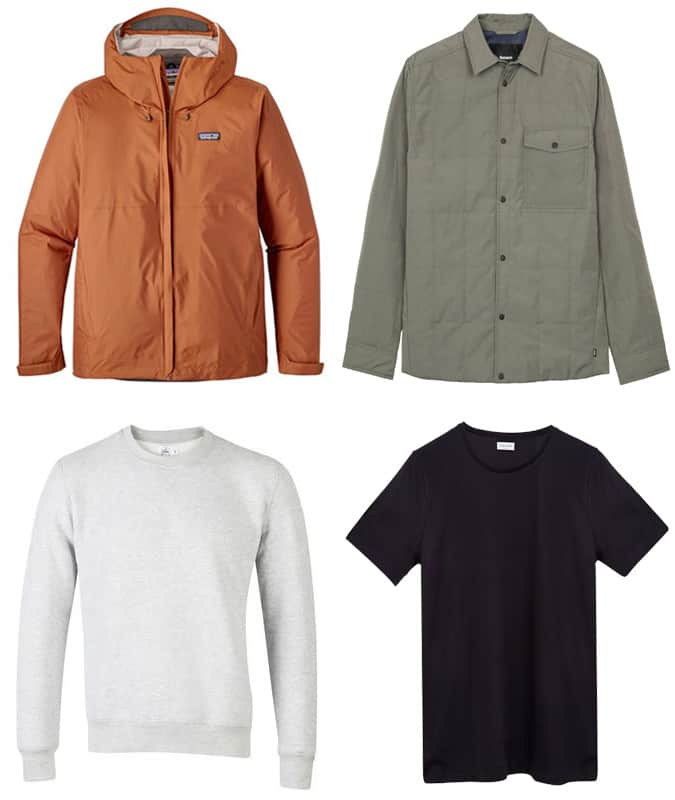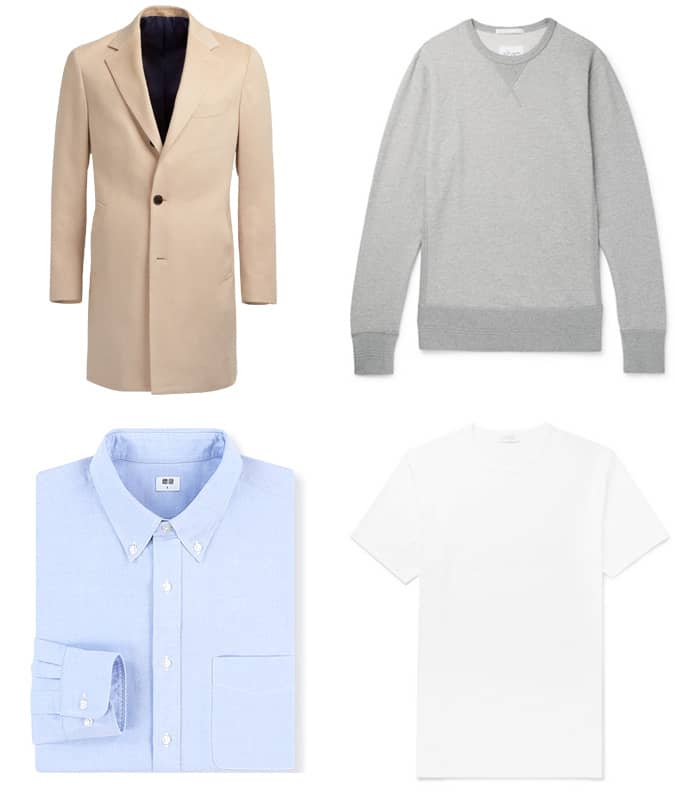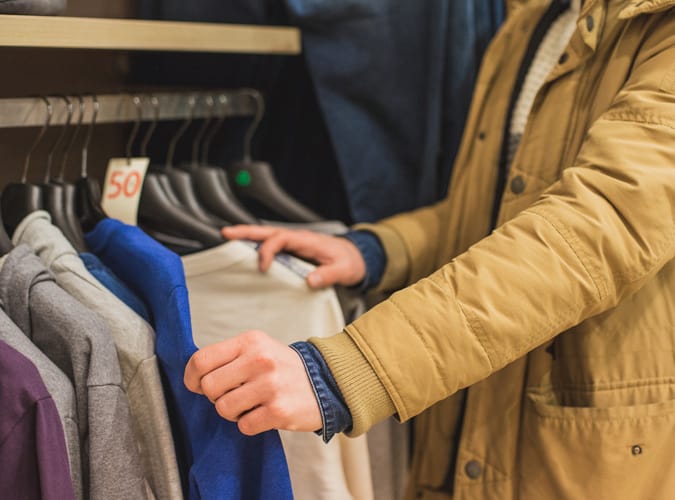No offence to eco-fashion warriors, but hemp overshirts and wicker onesies are not a good look. We don’t much like rummaging through dumpsters in the name of freeganism, either. On the other hand, we’re not overly keen on the irreversible destruction of the planet just so we can keep up with the latest trends in #menswear.
According to waste advisory body WRAP, more than 350,000 tonnes of clothes were sent to landfills in the UK alone in 2016. Dying garments to the season’s trending shade is the second biggest polluter of water globally, dumping dyes, inks, bleaches and minute fibres into the water cycle. And, according to The World Wide Fund for Nature, it can take up to a staggering 20,000 litres of water to produce just one T-shirt and a pair of jeans. Sobering stuff for next time you casually add to basket.
“Each morning when we wake up and get dressed, we can effect change,” says Orsola de Castro, co-founder of the Fashion Revolution organisation. “Just thinking, becoming more conscious, is a step in the right direction.”
Thankfully, there are ways to remap your sartorial habits without going on an extreme menswear diet. Here’s how to (figuratively) turn your wardrobe green. Please dress responsibly, but stylishly.
Take Stock Of Your Wardrobe
Like carrying a reusable shopping tote or refusing a plastic straw, creating a (figuratively) greener wardrobe is a simple but powerful act in the fight against climate change. And it can be a simple as doing a quick wardrobe itinerary before hitting ‘add to basket’.
“Look at the types of garments you already own, as well as colours and fabrications,” suggests Alex McIntosh, founder of the sustainable fashion consultancy Create Sustain.
“You might realise how much you have, remember and revive forgotten favourites, and make better decisions when buying something new.”

Buy From Brands That Promote Sustainability
Not so fun fact: WRAP puts the average lifespan of a garment in a developed country like the UK at a paltry 3.3 years. But that statistic is easily increased by adopting a buy less, buy better approach.
“Sustainability doesn’t have to be complicated, it can be as simple as buying from a brand that guarantees its products, so you don’t have to shell out again if anything happens to them,” explains Tom Cridland, a designer known for his range of 30-year sweatshirts. “We produce garments that are backed by a three-decade repair or replacement promise. They’re staples that don’t go in or out of fashion and are cornerstones of a wardrobe.” Eco-friendly and not woven from multi-coloured wicker – ace.
It’s not just how long your clobber lasts that matters, mind. A garment’s production methods can still leave the earth looking like a post-apocalyptic hellscape. It’s for this reason that Swedish brand A Day’s March makes a substantial amount of its products from organic cotton. “It’s harder to find really good shirt fabrics in eco-cotton compared to jersey fabrics, but it’s more environmentally friendly,” says creative director Pelle Lundquist.
Other planet-pleasing brands to look out for include Weekday, which swerves harmful chemicals in all its factories; Patagonia, which pledges a percentage of its profits to environmental groups; and Paper Wallet, which specialises in 100 per cent recyclable accessories that actually look good. Don’t discount the high street, either – the likes of H&M (Conscious line) and Mango (Committed line) are now producing dedicated environmentally-friendly collections each season.

Repair Your Old Clothes
The saying ‘If it ain’t broke, don’t fix it’ holds real water in menswear. But so too should ‘If it’s broke, fix it.’
“Most of us don’t think about mending a pair of jeans that have ripped at the crotch, or a jacket sleeve that’s been nibbled at by moths, but it is worth it,” says Lucinda O’Connor, founder of Clothes Doctor.
Make acquaintance with your local seamstress or dry cleaner, or use an online service such as the Clothes Doctor which will collect your damaged clothes and return them as good as new.
 Clothes Doctor
Clothes Doctor
Buy Timeless Pieces
When the new season stock hits stores, it’s easy to get carried away with a scattergun approach to shopping. And while it’s fine to top up your wardrobe with a few must-have pieces, it’s worth ensuring you’ve got a solid roster of trusty staples that won’t date in place first. The environment will thank you (in its own silent way), and so will your wallet.
“It’s important to have timeless staples in your wardrobe that you know can last season after season,” says celebrity stylist Alex Longmore. “The key pieces a man should have are a white and light blue shirt, a navy and grey sweatshirt, dark trousers, dark denim jeans, brown suede brogues or loafers, a smart winter coat, a smart belt and three block-colour T-shirts,” she adds.
Quality is another key factor in building a wardrobe that’ll go the distance and put an end to any wasteful ways. “When shopping for clients, I choose specific brands for what they do best,” says Timothy Lord, a stylist who has shaped the wardrobes of Michael Fassbender and Jude Law.
Carry out a stock-take of your wardrobe, and for any menswear heroes that are missing, research the best available for your budget. Because such pieces are outside of the hype-cycle, it’s possible to find them all on the high street.

Rent For Special Occasions
Hiring formalwear can conjure memories of ill-fitting prom suits and shiny wedding waistcoats, but the rental market has come on considerably.
It goes without saying that if you regularly wear a dinner suit (say, if you’re James Bond or at least attend a lot of corporate dos) it pays to invest. However, for a one-off event, tailoring specialists offer modern dinner and lounge suits that both look the part and – crucially – fit properly.
Renting is no longer just for occasions where you need to get trussed up, either. There are now sites and apps that allow you to loan everything from jeans to the latest grail jacket.
Stop Wearing Plastic
“Over half of the clothes binned in the UK are plastic-based,” says Ian Samuels, commercial director of historic menswear brand E Tautz. “Our consumption is off the charts, and it can’t continue.”
Before buying a garment, check its label for polyester, acrylic or nylon – all of which are just fancy names for plastic. Where possible, stick to pieces made from pure natural fibres such as cotton, linen and wool – remembering those that are made from just one fabric will be easier to recycle.
One of the biggest leaps in sustainable manufacturing is Lyocell (sometimes called Tencel) – a relatively new fabric made from wood pulp that has minimal environmental impact and is fully biodegradable. It’s similar to cotton in that it’s lightweight and breathable, making it ideal for tees and shirts.

Choose Looks That Are Trend-Proof
No man is an island, and staple pieces on their own aren’t going to be a silver bullet for your inner sartorial spendthrift. What you need to look out for are tried-and-tested outfit combinations that look cool but won’t date.
“Choosing good quality staple combinations is the key to having a sustainable wardrobe,” says men’s style writer George Nicholson. “Invest in outfits like a leather jacket, a quality white T-shirt and a pair of selvedge jeans, and you won’t need to replace the foundations of your wardrobe every year.”
Yes, the high street may be able to quickly knock up handsome wares that give you change from a tenner, but for the planet, the cost is way higher with CO2 emissions from the fast-fashion cycle expected to reach 60 per cent by 2030.
As well as staple pieces, staple colours should also be a point of focus. Neutrals and versatile shades of navy, black and grey offer up the most styling combinations – maximising on the magic cost-per-wear formula.

Love Your Scuffs
In the interest of honesty, we’ll just go ahead and say that we love a pair of box-fresh Common Projects as much as the next guy.
However, confessions aside, it’s also important to realise that maintaining that just-new look is completely at odds with going green.
Learn to embrace the odd scratch and scuff, and get out of the mindset that worn equals ruined. If you prefer your sneakers pristine, avoid anything white or suede, and stick to hard-wearing canvas and leather in darker colours.

Buy Fabrics That Are Hard-Wearing
If you’re going to buy clothes (and you’re here, so we’ll assume that you are), the easiest way to reduce your great, hulking human footprint is to take an interest in what they’re made from.
Beyond avoiding difficult-to-recycle fabric blends, the other thing you can do is shop for pieces that are hard-wearing. For example, a real leather jacket will set you back further than an imitation number, but the former will be trucking long after the latter has peeled and cracked beyond recognition.
Consider also the natural properties of fabrics. Merino wool, for example is anti-bacterial, so requires fewer washes after wear, which will in turn extend its shelf (or rather, wardrobe) life.

Look Out For Products And Services That Extend Life
Like a solid marriage, it takes constant work to keep a wardrobe in good nick. Assuming you already know to spray your suede and regularly polish your leather, make time for the more advanced methods for keeping your wardrobe evergreen.
Over-washing is an easy way to reduce a garment’s longevity and waste water. To remedy this, ensure your clothes have room to air when hanging in the wardrobe, and turn to garment refresh sprays if all that’s needed is a quick spruce. When you do need to put them through a spin cycle, consider specialist cleaning brands such as Mr Black, which produces enzyme-free washes specially formulated to keep your denim, cotton, wool and cashmere in pristine condition.
Of course, even the most cautious of men will eventually find their clothes give way. But before tossing something in the bin, inspect the damage to see if it can be repaired. Many ethical fashion brands now offer this service, from Barbour and Patagonia to Dr Martens and Nudie Jeans.
More often than not, a good tailor can suture suit trauma, alter sizing and even update a piece of tailoring with a new lining or buttons. Beyond that, footwear care brands like Sneakers ER produce clever kits and offer in-store services to bring tatty trainers back to life, while greying whites can be revived up via non-bleach washing specialists like The Laundress.

Buy Second-Hand Online
It’s often said that the most sustainable clothing is already in your wardrobe, but sometimes it’s hanging up in somebody else’s, waiting to be re-sold.
Use second-hand and resale sites such as Depop (great for sportswear and all things nineties), Grailed (full of cult brands and rare finds) and Vestiare Collective (for authentic high-end designer pieces) to shop without guilt.
Keep a flexible tape measure to hand at home to size up garments you already own, so that you can compare them to items for sale.

Ask The Big Questions Before Buying
A wise man once said, “It’s hard to know the answer if you don’t have the questions.” In fact, that man was Mart Drake-Knight, founder of award-winning sustainable fashion brand Rapanui. As he has a point.
“Ask where does the stuff you buy come from, and where does it go when you’re done with it. Not just who made it or how it was made, but what it is made from.”
Start by checking out a brand’s website – those that are truly ethical are usually among the most transparent. Keep an eye out for the B Corp certification, which means a company has committed to ethical practices at all levels.
Seek Out Sample Sales
There’s no getting around the fact that some – but not all – sustainable brands cost more than the high street equivalent, but many will often hold sample sales where you can grab a bargain.
“Try not to be too spur of the moment – buy something you know you’re doing to love,” says de Castro – advice which is true for any purchase.
To find out about sales sign up to newsletters, follow brands on social media, or check listings websites such as Chicmi.


